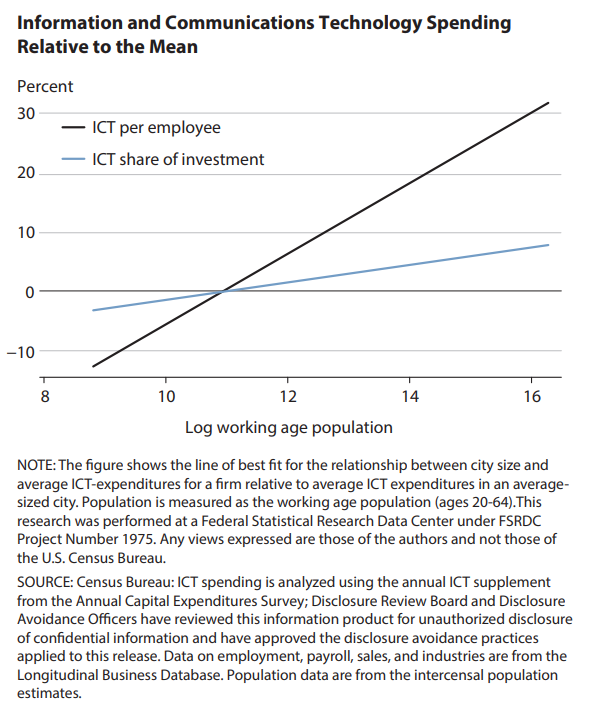Firms in Big Cities Spend Relatively More on Technology
The widespread adoption of new technology is important for economic growth, but such adoption has been uneven across the U.S., as discussed in an Economic Synopses essay earlier this year.
“Firms in big cities have spent more money per employee and a larger share of their total investment budget on new information and communications technology (ICT) than firms in small cities,” wrote Economist Hannah Rubinton and Research Associate Maggie Isaacson.
In addition to examining the relationship between firms’ ICT spending and city size, the authors discussed what drives higher rates of ICT spending in big cities.
Technology Divide
ICT spending includes payments for the purchase, rental, lease and maintenance of software, computer equipment and related ICT materials, Rubinton and Isaacson explained.
The authors examined the relationship between city size and firm-level ICT spending, relative to ICT spending in an average-sized city. The authors controlled for differences such as a firm’s age, number of employees and industry. The results are shown in the figure below.

Rubinton and Isaacson found that firms in big cities have more ICT spending. For example, those in the largest cities, like New York and Los Angeles, spend over 30% more on ICT-related expenses per employee than firms in average-sized cities and about 8% more of their total investment budgets on these expenses. Those numbers differ greatly from firms in the smallest cities.
“The figure also tells us that firms in the smallest cities spend 12 percent less on ICT-related expenses per employee than firms in average-sized cities and about 2 percent less of their total investment budget on ICT-related expenses,” Rubinton and Isaacson wrote.
Driving Technology Spending
In discussing why big cities would have higher rates of ICT spending, Rubinton and Isaacson drew on a 2020 working paper by Rubinton. They described three city-level features that drive technology adoption:
- Big-city firms have expanded markets in which to sell their products, which allow them to divide a fixed cost for technological innovation across more units of production, Rubinton and Isaacson pointed out.
- If ICT and skilled labor go hand in hand, firms will adopt more technology in cities where they can easily and cheaply find skilled labor, and that type of labor pool is deeper in large cities, the authors noted.
- Firms will adopt more ICT in cities that are more productive in using skilled labor, they posited.
“In the United States, big cities tend to have a relatively larger supply of skilled workers and are more productive in using skilled workers,” Rubinton and Isaacson wrote. “Thus, all three of these channels may be important drivers of greater technology adoption by firms in big cities relative to small cities.”
A Growing Gap
The uneven adoption of technology among firms in large and small cities has other economic effects. For instance, it tends to increase the relative wages and relative supply of skilled workers in big cities, the authors noted.
Rubinton and Isaacson suggested that differences in technology adoption are likely a cause of the growing economic divide between large and small U.S. cities.
Citation
ldquoFirms in Big Cities Spend Relatively More on Technology,rdquo St. Louis Fed On the Economy, Dec. 13, 2021.
This blog offers commentary, analysis and data from our economists and experts. Views expressed are not necessarily those of the St. Louis Fed or Federal Reserve System.
Email Us
All other blog-related questions

